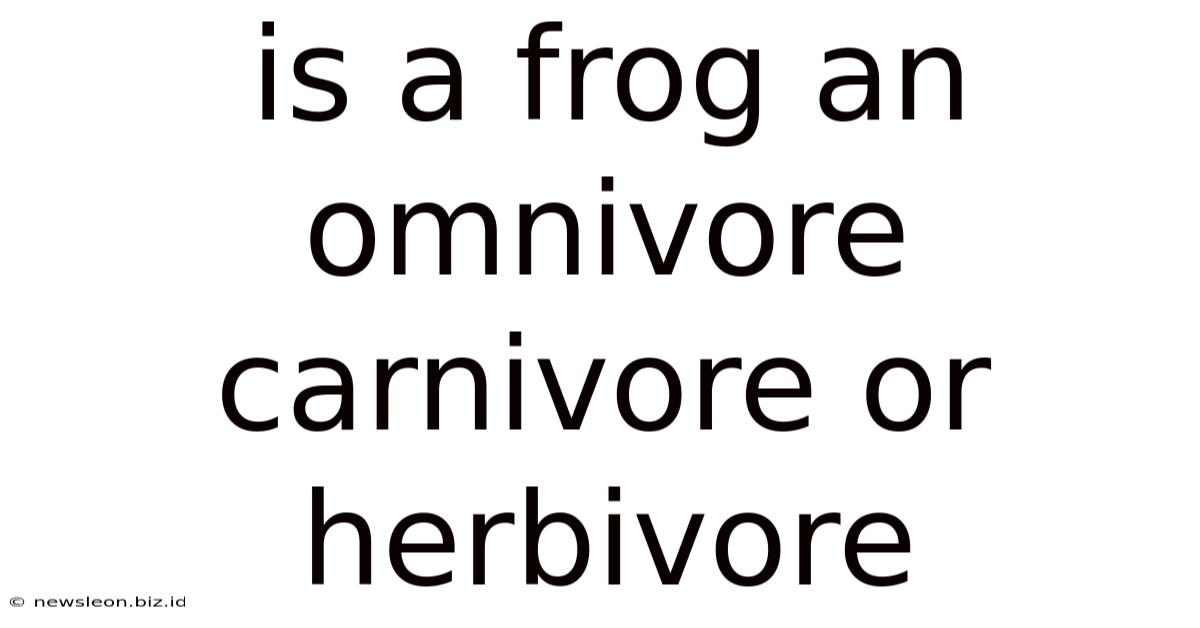Is A Frog An Omnivore Carnivore Or Herbivore
News Leon
May 03, 2025 · 5 min read

Table of Contents
Is a Frog an Omnivore, Carnivore, or Herbivore? A Deep Dive into Frog Diets
Frogs, those charming amphibians with their bulging eyes and long, sticky tongues, are a fascinating subject of study. But when it comes to their diet, the answer isn't as straightforward as you might think. While many people assume frogs are solely carnivorous, the truth is far more nuanced, varying significantly depending on the species, age, and availability of food sources. This comprehensive guide delves deep into the dietary habits of frogs, exploring the different types of frogs and their respective food preferences to definitively answer the question: is a frog an omnivore, carnivore, or herbivore?
The Predominantly Carnivorous Nature of Frogs
The vast majority of frog species are carnivores, meaning their diet primarily consists of animal matter. Their anatomy is perfectly adapted for capturing and consuming prey. Their powerful legs allow for quick bursts of speed to catch unsuspecting insects, while their long, sticky tongues act as efficient traps, snatching prey with remarkable accuracy. Their sharp teeth, while not used for chewing (frogs swallow their food whole!), help to secure struggling prey.
Common Prey Items for Carnivorous Frogs
The specific prey items vary greatly depending on the frog's size and habitat, but generally include:
-
Insects: This is the cornerstone of most frog diets. Flies, mosquitoes, beetles, grasshoppers, crickets, and ants are all common targets. Larger frogs might even consume larger insects like dragonflies or moths.
-
Other invertebrates: Beyond insects, many frogs prey on spiders, worms, snails, slugs, and even small crustaceans.
-
Small vertebrates: Some larger frog species, particularly those inhabiting aquatic environments, will consume small fish, tadpoles (even their own!), newts, and even small rodents or birds. This is particularly true for bullfrogs and other large, predatory species.
Adaptations for a Carnivorous Lifestyle
The morphology of frogs is a testament to their carnivorous nature. Their:
- Powerful leg muscles: Enable quick acceleration and jumps to ambush prey.
- Long, sticky tongue: A highly specialized organ for capturing prey from a distance.
- Sharp, backward-pointing teeth: Secure prey and prevent escape.
- Short digestive tract: Reflects their diet of easily digestible animal matter.
The Exceptions: Omnivorous and Herbivorous Frogs
While most frogs are primarily carnivorous, there are exceptions. Some species exhibit omnivorous tendencies, meaning they consume both plants and animals. Others, though exceedingly rare, might display a preference for plant matter, exhibiting herbivorous traits. Let's explore these less common dietary habits:
Omnivorous Frogs: A Blend of Animal and Plant Matter
Some frog species supplement their primarily carnivorous diet with plant material. This isn't a consistent, substantial portion of their diet, but rather an occasional inclusion. These frogs might consume:
- Algae: Aquatic frogs might consume algae growing on rocks or aquatic plants.
- Fruits and berries: Certain terrestrial frogs might occasionally consume fallen fruits or berries.
- Flower petals: Some species have been observed consuming flower petals, though this likely contributes minimally to their overall caloric intake.
It's crucial to understand that even in omnivorous frogs, animal matter still constitutes the bulk of their diet. The consumption of plant matter is often opportunistic or supplemental.
Herbivorous Frogs: The Rarity
True herbivorous frogs are incredibly rare. The majority of scientific literature focuses on the carnivorous or omnivorous tendencies of frogs. There's limited documented evidence of frog species relying primarily on plant matter for sustenance. While some species might occasionally consume plant material, their physiological adaptations are not suited for an entirely herbivorous lifestyle. Their digestive systems are designed to process animal protein efficiently, and lacking the necessary enzymes for efficient plant digestion.
Factors Influencing Frog Diets: Age and Habitat
The diet of a frog is not static; it changes throughout its lifecycle and is heavily influenced by its environment.
Tadpole Stage: A Primarily Herbivorous Phase (Mostly)
In their larval stage (tadpole), most frogs are predominantly herbivores, primarily consuming algae and other aquatic plants. This reflects their different physiological requirements during this developmental stage. They lack the necessary organs for capturing and consuming animal prey. However, some tadpoles are omnivorous and may consume small invertebrates.
Juvenile and Adult Frogs: The Shift to Carnivory
As frogs mature into juveniles and adults, they undergo a significant dietary shift. Their physiological development allows them to hunt and consume animal prey efficiently. The transition to carnivory is largely driven by the need for more protein and nutrients to support their growth and energy requirements.
Habitat Influence on Diet
The availability of food sources directly impacts a frog's diet. A frog inhabiting an area rich in insects will have a primarily insectivorous diet, while a frog living near a pond with an abundance of small fish might consume more fish. The environment essentially dictates what food items are readily available and accessible, shaping the frog's dietary preferences accordingly.
Conclusion: Mostly Carnivorous, with Occasional Omnivory
To definitively answer the question: is a frog an omnivore, carnivore, or herbivore? The most accurate response is that the vast majority of frogs are carnivores, with a significant portion exhibiting omnivorous tendencies. The rare cases of predominantly herbivorous frogs are extremely uncommon and lack substantial scientific documentation. The age of the frog, its species, and the environmental context greatly influence its diet, resulting in the wide array of dietary behaviors observed across the various frog species. However, understanding the primarily carnivorous nature of frogs, coupled with the occasional inclusion of plant matter in some species, provides a comprehensive understanding of their fascinating feeding habits.
Latest Posts
Related Post
Thank you for visiting our website which covers about Is A Frog An Omnivore Carnivore Or Herbivore . We hope the information provided has been useful to you. Feel free to contact us if you have any questions or need further assistance. See you next time and don't miss to bookmark.